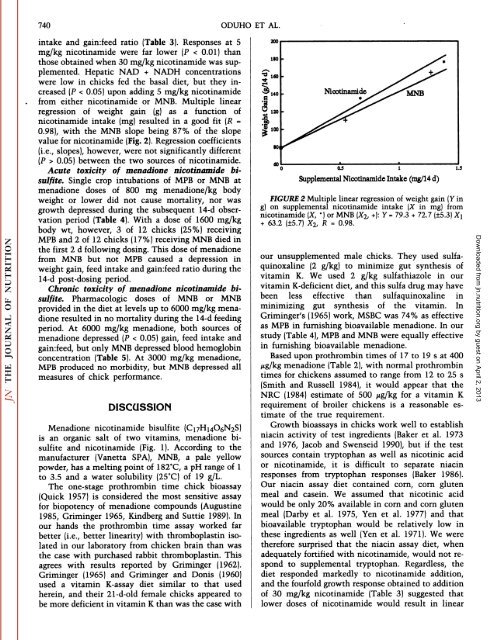Menadione Nicotinamide Bisulfite Is a Bîoactîve Source of ...
Menadione Nicotinamide Bisulfite Is a Bîoactîve Source of ...
Menadione Nicotinamide Bisulfite Is a Bîoactîve Source of ...
You also want an ePaper? Increase the reach of your titles
YUMPU automatically turns print PDFs into web optimized ePapers that Google loves.
740 ODUHO ET AL.<br />
intake and gain:feed ratio (Table 3). Responses at 5<br />
mg/kg nicotinamide were far lower (P < 0.01) than<br />
those obtained when 30 mg/kg nicotinamide was sup<br />
plemented. Hepatic NAD + NADH concentrations<br />
were low in chicks fed the basal diet, but they in<br />
creased (P < 0.05) upon adding 5 mg/kg nicotinamide<br />
from either nicotinamide or MNB. Multiple linear<br />
regression <strong>of</strong> weight gain (g) as a function <strong>of</strong><br />
nicotinamide intake (mg) resulted in a good fit (R =<br />
0.98), with the MNB slope being 87% <strong>of</strong> the slope<br />
value for nicotinamide (Fig. 2). Regression coefficients<br />
(i.e., slopes), however, were not significantly different<br />
(P > 0.05) between the two sources <strong>of</strong> nicotinamide.<br />
Acute toxicity <strong>of</strong> menadione nicotinamide bi<br />
sulfite. Single crop intubations <strong>of</strong> MPB or MNB at<br />
menadione doses <strong>of</strong> 800 mg menadione/kg body<br />
weight or lower did not cause mortality, nor was<br />
growth depressed during the subsequent 14-d obser<br />
vation period (Table 4). With a dose <strong>of</strong> 1600 mg/kg<br />
body wt, however, 3 <strong>of</strong> 12 chicks (25%) receiving<br />
MPB and 2 <strong>of</strong> 12 chicks (17%) receiving MNB died in<br />
the first 2 d following dosing. This dose <strong>of</strong> menadione<br />
from MNB but not MPB caused a depression in<br />
weight gain, feed intake and gain:feed ratio during the<br />
14-d post-dosing period.<br />
Chronic toxicity <strong>of</strong> menadione nicotinamide bi<br />
sulfite. Pharmacologie doses <strong>of</strong> MNB or MNB<br />
provided in the diet at levels up to 6000 mg/kg mena<br />
dione resulted in no mortality during the 14-d feeding<br />
period. At 6000 mg/kg menadione, both sources <strong>of</strong><br />
menadione depressed (P < 0.05) gain, feed intake and<br />
gain:feed, but only MNB depressed blood hemoglobin<br />
concentration (Table 5). At 3000 mg/kg menadione,<br />
MPB produced no morbidity, but MNB depressed all<br />
measures <strong>of</strong> chick performance.<br />
DISCUSSION<br />
<strong>Menadione</strong> nicotinamide bisulfite<br />
is an organic salt <strong>of</strong> two vitamins, menadione bi<br />
sulfite and nicotinamide (Fig. 1). According to the<br />
manufacturer (Vanetta SPA), MNB, a pale yellow<br />
powder, has a melting point <strong>of</strong> 182°C,a pH range <strong>of</strong> 1<br />
to 3.5 and a water solubility (25°C)<strong>of</strong> 19 g/L.<br />
The one-stage prothrombin time chick bioassay<br />
(Quick 1957) is considered the most sensitive assay<br />
for biopotency <strong>of</strong> menadione compounds (Augustine<br />
1985, Griminger 1965, Kindberg and Suttie 1989). In<br />
our hands the prothrombin time assay worked far<br />
better (i.e., better linearity) with thromboplastin iso<br />
lated in our laboratory from chicken brain than was<br />
the case with purchased rabbit thromboplastin. This<br />
agrees with results reported by Griminger (1962).<br />
Griminger (1965) and Griminger and Donis (1960)<br />
used a vitamin K-assay diet similar to that used<br />
herein, and their 21-d-old female chicks appeared to<br />
be more deficient in vitamin K than was the case with<br />
0.5<br />
Supplemental<strong>Nicotinamide</strong>Intake (mg/14d)<br />
FIGURE 2 Multiple linear regression <strong>of</strong> weight gain (Y in<br />
g) on supplemental nicotinamide intake [X in mg) from<br />
nicotinamide (X, *) or MNB (X2, +): Y = 79.3 + 72.7 (±5.3)X\<br />
+ 63.2 (±5.7)Xi, R = 0.98.<br />
our unsupplemented male chicks. They used sulfaquinoxaline<br />
(2 g/kg) to minimize gut synthesis <strong>of</strong><br />
vitamin K. We used 2 g/kg sulfathiazole in our<br />
vitamin K-deficient diet, and this sulfa drug may have<br />
been less effective than sulfaquinoxaline in<br />
minimizing gut synthesis <strong>of</strong> the vitamin. In<br />
Griminger's (1965) work, MSBC was 74% as effective<br />
as MPB in furnishing bioavailable menadione. In our<br />
study (Table 4), MPB and MNB were equally effective<br />
in furnishing bioavailable menadione.<br />
Based upon prothrombin times <strong>of</strong> 17 to 19 s at 400<br />
Mg/kg menadione (Table 2), with normal prothrombin<br />
times for chickens assumed to range from 12 to 25 s<br />
(Smith and Russell 1984), it would appear that the<br />
NRC (1984) estimate <strong>of</strong> 500 Mg/kg for a vitamin K<br />
requirement <strong>of</strong> broiler chickens is a reasonable es<br />
timate <strong>of</strong> the true requirement.<br />
Growth bioassays in chicks work well to establish<br />
niacin activity <strong>of</strong> test ingredients (Baker et al. 1973<br />
and 1976, Jacob and Swenseid 1990), but if the test<br />
sources contain tryptophan as well as nicotinic acid<br />
or nicotinamide, it is difficult to separate niacin<br />
responses from tryptophan responses (Baker 1986).<br />
Our niacin assay diet contained corn, corn gluten<br />
meal and casein. We assumed that nicotinic acid<br />
would be only 20% available in corn and corn gluten<br />
meal (Darby et al. 1975, Yen et al. 1977) and that<br />
bioavailable tryptophan would be relatively low in<br />
these ingredients as well (Yen et al. 1971). We were<br />
therefore surprised that the niacin assay diet, when<br />
adequately fortified with nicotinamide, would not re<br />
spond to supplemental tryptophan. Regardless, the<br />
diet responded markedly to nicotinamide addition,<br />
and the fourfold growth response obtained to addition<br />
<strong>of</strong> 30 mg/kg nicotinamide (Table 3) suggested that<br />
lower doses <strong>of</strong> nicotinamide would result in linear<br />
Downloaded from<br />
jn.nutrition.org<br />
by guest on April 2, 2013
















